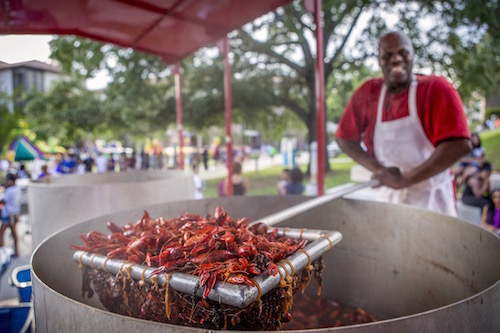Introduction to Sociology
Tổng quan các chủ đề
-
Module 2: Culture
 Figure 2.1 Crawfish boils where friends, family, and strangers who become friends all gather for a good time, good food, and good conversation. (https://www.lsu.edu/images/2015/uppertierpages/crawfish.jpeg)
Figure 2.1 Crawfish boils where friends, family, and strangers who become friends all gather for a good time, good food, and good conversation. (https://www.lsu.edu/images/2015/uppertierpages/crawfish.jpeg)
 Introduction
Introduction
What are the rules when you pass an acquaintance at school, work, in the grocery store, or in the mall? Generally, we do not consider all of the intricacies of the rules of behavior. We may simply say, "Hello!" and ask, "How was your weekend?" or some other trivial question meant to be a friendly greeting. Rarely do we physically embrace or even touch the individual. In fact, doing so may be viewed with scorn or distaste, since as people in the United States we have fairly rigid rules about personal space. However, we all adhere to various rules and standards that are created and maintained in culture. These rules and expectations have meaning, and there are ways in which you may violate this negotiation. Consider what would happen if you stopped and informed everyone who said, "Hi, how are you?" exactly how you were doing that day, and in detail. You would more than likely violate rules of culture and specifically greeting. Perhaps in a different culture the question would be more literal, and it may require a response. Or if you are having coffee with a good friend, perhaps that question warrants a more detailed response. These examples are all aspects of culture, which are shared beliefs, values, and practices, that participants must learn. Sociologically, we examine in what situation and context certain behavior is expected, and in which situations perhaps it is not. These rules are created and enforced by people who interact and share culture.
In everyday conversation, people rarely distinguish between the terms culture and society, but the terms have slightly different meanings, and the distinction is important to a sociologist. A society describes a group of people who share a community and a culture. By “community,” sociologists refer to a definable region—as small as a neighborhood (Brooklyn, or “the east side of town”), as large as a country (Ethiopia, the United States, or Nepal), or somewhere in between (in the United States, this might include someone who identifies with Southern or Midwestern society). To clarify, a culture represents the beliefs and practices of a group, while society represents the people who share those beliefs and practices. Neither society nor culture could exist without the other. In this chapter, we examine the relationship between culture and society in greater detail and pay special attention to the elements and forces that shape culture, including diversity and cultural changes. A final discussion touches on the different theoretical perspectives from which sociologists research culture.
 Module Objectives
Module Objectives- Explain material learned of culture, social structures, and social institutions. (CLO 3)
- Recognize cultural and individual differences that underline the complexities of human behavior and social interaction. (CLO 5)
- Discuss theoretical approaches to cultural interpretation. (CLO 2)
MODULE ACTIVITIES
- Read the Module 2 Introduction
- Read Chapter 2 Introduction to Culture in The Introduction to Sociology Pressbook Text.
 DISCUSS
DISCUSSRespond to the discussion prompts and questions by the due dates outlined in the assignment.
 SUBMIT
SUBMITSubmit your completed assignments by the due date assigned to each assignment.
- Watch the following video:
- CrashCourse (2017, May 22). Cultures, Subcultures, and Countercultures #11. [Video]. YouTube.
4. Complete the [specific activities in the module. Include all in the order you want them completed.]Module Pressbooks Resources and Activities
You will find the following resources and activities in this module at the Pressbooks website. Click on the links below to access or complete each item.
-
Forum Instructions
In a post below, respond to the following prompt, which assesses course outcomes 3 and 4 and module learning objectives Elements of Culture and Pop Culture, Subculture, and Cultural Change. Then, you must respond to one of your classmates' posts. After you post a response, you will be able to see other responses. You are not required to post more than once, but feel free to respond to other posts and engage with your classmates.
In your response to a peer, a simple “I agree” or “Yes” or “LOL” will not count. Please think about the questions and your peers' responses and reply thoughtfully and courteously, according to netiquette rules. Use good English grammar, correct punctuation, and complete sentences. While the posts will mostly be judged by their thoughtfulness and completeness, I reserve the right to take off points for grammatical errors, especially if they interfere with the clarity of the post.
Prompt
Instructor
Details:
A forum for discussion promotes peer-to-peer and student-instructor interaction. Questions should be thought provoking and encourage detailed analysis of module topics. Include a rubric.
If you do not want students to see other responses before they post, set type to "Q and A forum." For this type, you must create a post first for students to respond.
Subscription: Set to Auto.
Due dates: You cannot set due dates for forums, so be sure to tell students when to post above. These dates will not appear on the Moodle calendar.
Ratings: will place the forum in the gradebook. You can set a maximum grade. Restricting ratings to a date range only affects when you can grade, and not when the activity is available to students.
Activity completion: Select completion criteria and an expected completed date.